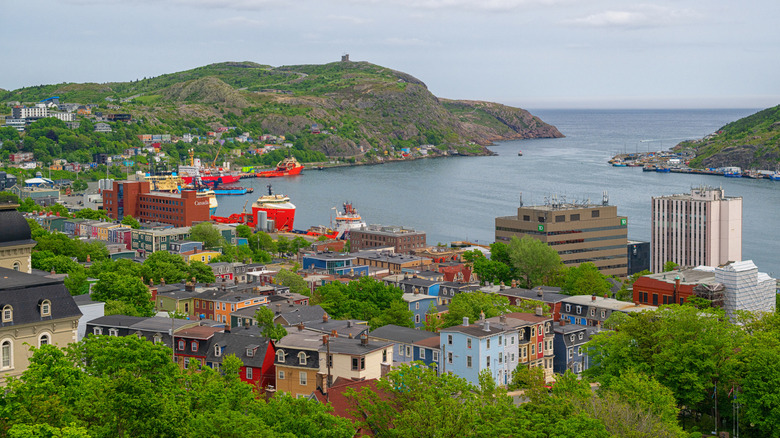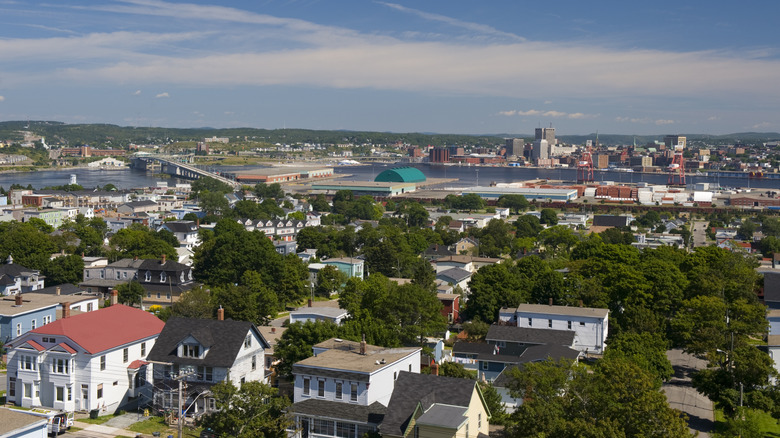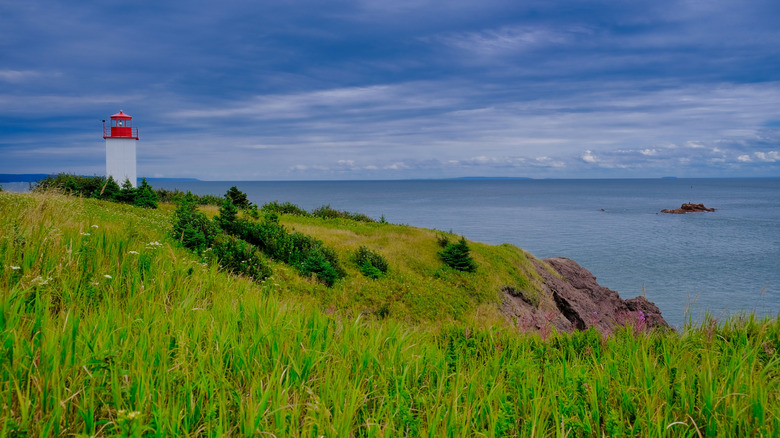Why A Visit To Canada's St. John's Requires Some Double-Checking Before Booking Your Trip
So you've decided to take a Canadian road trip. How exciting! The rugged coasts and windswept villages of Eastern Canada are calling your name, and you realize how reasonable it is to drive up from New England and explore these scenic Atlantic provinces. You've taken some French lessons on Duolingo. You've got a hankering for poutine. You've read our helpful guide about how to road trip through Canada. Soon, you'll be driving up to Saint John ... er, um, St. John's? Wait ... where are we going again?
For such a close neighbor, Canada remains little-known to most Americans, who probably couldn't tell you the nation's capital or identify even half the provinces on a blank political map. Even converting to kilometric speed limits and red signs marked "arrêt" instead of "stop" throw us into a panic. One of the many little confusions for U.S. travelers is a town named after a saint — or rather, two different towns in two totally different provinces that might mess with your GPS.
In short: "Saint John" (with a spelled-out "Saint" and name-only) is a town in New Brunswick. "St. John's" (with an abbreviated "St." and a possessive apostrophe) is in Newfoundland. They may seem close together on a map of the world, but the two destinations are over 1,000 miles apart, including a significant ferry ride.
Saint John, New Brunswick, at a glance
Not only are their names similar, but the two towns have a good amount in common: They're both seaside communities on the southern coasts of their respective provinces. They're both based on very old colonies, and Saint John in New Brunswick is technically Canada's oldest incorporated city, dating back to the early 1600s. They both have harbors and a longtime maritime economy. Even their populations are comparable: St. John's has about 110,000 residents, while Saint John has about 70,000.
But there are plenty of differences: Saint John is a much easier destination for road-trippers to reach, whether they're coming from the U.S. or mainland Canada. More than half of New Brunswick's terrestrial border is with the state of Maine, and the rest abuts the province of Quebec. Saint John has several historic museums, there's a robust dining scene — including seafood, Latin, and Pan-Asian options — and a nice selection of boutique retail stores.
Most unique of all is Saint John's location on the Bay of Fundy, which experiences the most dramatic tidal shifts on the planet. This is most evident at the junction between the bay and the Saint John River, where high tide effectively pushes the river's flow backward. Known as the Reversing Falls Rapids, Saint John is one of the few places in the world you can observe this type of hydrologic fluke. If you're dying to see this event in person, consider a visit to the underrated Fundy National Park, a little over an hour away by car.
St. John's, the urban heart of Newfoundland
St. John's is located in the southeast corner of Newfoundland, an island-province that is officially paired with mainland Labrador. Pronounced in many different ways, Newfoundland is famous for its rocky seascapes, rugged hills, wild puffin populations, and a culture heavily influenced by Irish and English immigrants. Newfoundland is a massive chunk of land, shaped like an arrowhead and covered in mountains. Inhabited for thousands of years by Indigenous peoples and briefly colonized by Norse explorers, Newfoundland is still a very rural province with large stretches of wilderness; the population density of both Newfoundland and Labrador together is about 1.5 people per square kilometer.
As a result, St. John's is considered the "big city" in Newfoundland, with colorful cottages perched on the rocky coast and pubs and restaurants aplenty. St. John's doesn't provide direct ferry service to either Nova Scotia or Labrador, so drivers will have to ride over to Argentia, about 90 minutes away, or Channel-Port aux Basques, which is nine hours away. This is a mystical part of Canada, where mist-shrouded hilltops, remote beaches, and spouting whales are regular sights on a summer drive. St. John's has plenty of proper lodging and a robust nightlife and entertainment scene, especially in the warmer months. No matter when you visit, it's perfectly reasonable for a visitor in Newfoundland to spot an iceberg floating by.
In short, the two towns may not be the same, but each is an essential gateway to Eastern Canada. Saint John in New Brunswick is closer and doesn't require a ferry; St. John's is your springboard to Newfoundland's primal landscape. Whichever you choose, assume the seafood is delicious.


